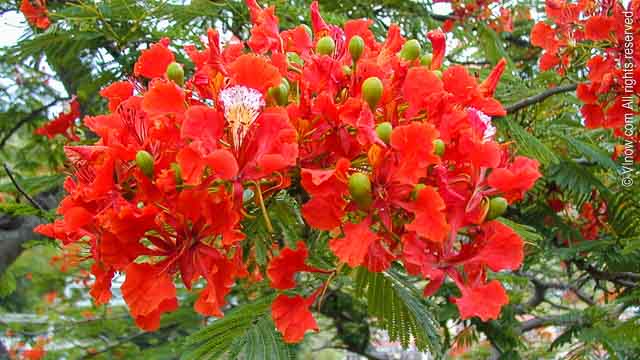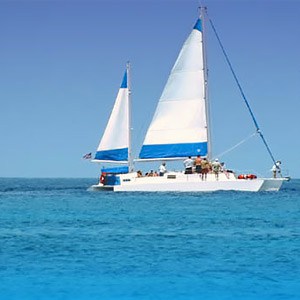If you have ever visited the USVI during the summer, you would have undoubtedly noticed bold, striking splashes of orange-red standing out from the otherwise green hills. These glorious bursts of color are the mark of the Royal Poinciana. In the USVI it is called Flamboyant, and if you have ever seen this tree in bloom you would know the reason right away.
Many consider the Flamboyant among the most beautiful trees in the world. It requires a tropical or near-tropical climate and can tolerate drought and salty conditions. It is well established throughout the Caribbean where it is adored for its beauty. In Puerto Rico, for example, many paintings feature the Flamboyant. It is the national flower of St. Kitts and Nevis. It is on postage stamps from Dominica, Anguilla and Montserrat. Though strongly associated with the Caribbean this spectacular tree is native to Madagascar.
While admired for its beauty home owners in the USVI do keep a watchful eye on where Flamboyant trees grow. The dense shade and root system prevent the growth of other species under it and its wide-spreading roots can be a threat to building foundations and sidewalks.
In the wild on its native Madagascar the Flamboyant is endangered. It is however widely grown and cultivated in other parts of world including Hong Kong, the Canary Islands, Taiwan and southern China. In the United States, it grows in South and Southwest Florida, the Rio Grande Valley of South Texas, low deserts of Southern Arizona, Southern California and Hawaii. It is also found in Guam and the Commonwealth of the Northern Mariana Islands.
The scientific name for this tree is Delonix regia; it is a species of flowering plant from the Fabaceae family. All Fabaceae have pods and on the Flamboyant the brown pods that develop can grow up to 18 inches long and two inches wide! The long brown pods become particularly conspicuous during the dry season when the tree sheds its leaves and is bare with the exception of the pods. (In areas that do not have a dry season the tree retains its foliage year round.) The seed pods are used in the Caribbean, including the USVI, as a percussion instrument known as a ‘shack-shack’.
Flamboyant trees can typically reach 15 feet in height but can grow as tall as 40 feet. It has a wide-spreading umbrella like canopy and can take up to 10 years to mature. The leaves of the tree are fine, lacy, soft and delicate leaflets.
In the late 1940’s Ariel Melchior, Sr., who was the owner of the newspaper on St. Thomas, is said to have paid local children to collect as many Flamboyant seeds as they could find. Melchior with the help of his friend and pilot Jack Monsanto then headed to the skies and dispersed the seeds over the islands. The wide popularity of the Flamboyant all over hills and valleys in the USVI is attributed to their actions.
While the pods are popular and leaflets delicate it is the brilliant flowers that demands attention. The individual flowers can be up to four inches across and have five petals in each flower; one is marked with lighter white and yellow stripes. The flowers range from deep red to orange-red. There is also a rare, naturally occurring, yellow variety (var. Flavida). The flowers grow from the ends of each branch and the tree typically remains in bloom for 2 to 4 months. In the Virgin Islands the tree flowers between May to September. If you visit the islands during those months, scan the hillsides for the brilliant Flamboyant you are bound to see many!
Flamboyant Flower Game: Children in the USVI and other islands of the Caribbean play a game with Flamboyant Flowers, or rather the not as yet bloomed flowers. The mature green flower pod is picked and carefully opened. The petals are pulled away exposing the stamen. The game is played with two people, each armed with a stamen. Stamens are hooked at the anthers and then each player gives a soft yank. The goal is to pull the opponents anther off without breaking your own. Play until all the stamens are finished. The person with the most points wins.
What’s In A Name: The Royal Poinciana was allegedly named “Poinciana” by the English on St. Kitts in honor of the French governor, Phillipe de Longviliers de Poincy. Some credit de Poincy with introducing the plant to the Americas; this would date the tree’s presence in the Caribbean to the 17th century.




